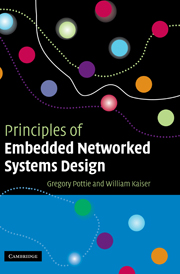Book contents
- Frontmatter
- Contents
- Preface
- Acknowledgments
- List of Abbreviations
- 1 Embedded network systems
- 2 Representation of signals
- 3 Signal propagation
- 4 Sensor principles
- 5 Source detection and identification
- 6 Digital communications
- 7 Multiple source estimation and multiple access communications
- 8 Networking
- 9 Network position and synchronization services
- 10 Energy management
- 11 Data management
- 12 Articulation, mobility, and infrastructure
- 13 Node architecture
- 14 Network data integrity
- 15 Experimental systems design
- 16 Ethical, legal, and social implications of ENS
- 17 Design principles for ENS
- Appendix A Gaussian Q function
- Appendix B Optimization
- Index
9 - Network position and synchronization services
Published online by Cambridge University Press: 10 August 2009
- Frontmatter
- Contents
- Preface
- Acknowledgments
- List of Abbreviations
- 1 Embedded network systems
- 2 Representation of signals
- 3 Signal propagation
- 4 Sensor principles
- 5 Source detection and identification
- 6 Digital communications
- 7 Multiple source estimation and multiple access communications
- 8 Networking
- 9 Network position and synchronization services
- 10 Energy management
- 11 Data management
- 12 Articulation, mobility, and infrastructure
- 13 Node architecture
- 14 Network data integrity
- 15 Experimental systems design
- 16 Ethical, legal, and social implications of ENS
- 17 Design principles for ENS
- Appendix A Gaussian Q function
- Appendix B Optimization
- Index
Summary
Spatio-temporal relationships for physical phenomena are critical observation features, whether for point or distributed sources. To determine the location and time of events, and how they evolve in space and time, the sensors must know their own position and the time. Many techniques for determining location in turn depend on having precise time references. Thus the two topics of localization and synchronization are closely connected. This chapter begins with an overview of techniques for determining position, assuming synchronism is available. The next section explores how synchronism can be obtained in a network, with the following section discussing how position can be determined in a network. The chapter concludes with a brief discussion of sources of error and how they can be mitigated.
Principles of location
Location, the computation of position, has historically been considered as a component of surveying or navigation. In either case, known reference points are used to compute the present position. In surveying, this allows new reference points to be constructed, enabling map-making. In navigation, the objective is to chart a course using references or a map. Both celestial and land references have been used, and more recently electronic beacons and satellites have been constructed to aid both tasks.
Triangulation
References are required for orientation (to set up the coordinate axes) and position. Traditional survey instruments establish the direction of gravity, and measure angles in azimuth (the horizontal plane), elevation, or both.
- Type
- Chapter
- Information
- Principles of Embedded Networked Systems Design , pp. 274 - 308Publisher: Cambridge University PressPrint publication year: 2005



